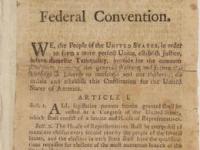Though the Preamble holds no legal powers within the Constitutional context, it does provide the interpretive framework for understanding this founding document. By using such phrases as “We the People,” the Preamble makes clear that the power of government comes from the people and is accountable to the people, firmly establishing the concept of Popular Sovereignty. It also establishes the purpose and ambition of the Constitution to create “a more perfect union” than those governmental bodies that have come before.
Students who can decode the language of the Preamble will be able to contextualize the U.S. Constitution and formulate a deeper understanding of both the ideas and principles behind it. In this lesson, the students will read and then synthesize the Preamble into their own words. Then they will compare and contrast an earlier version of the Preamble to the final version to gain an understanding of how the language of the Preamble changed to better align with such founding principles as Popular Sovereignty and Federalism.


